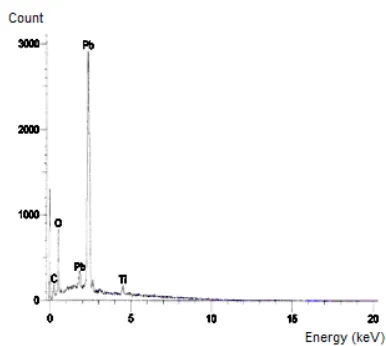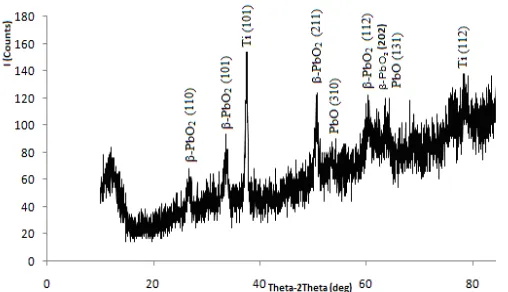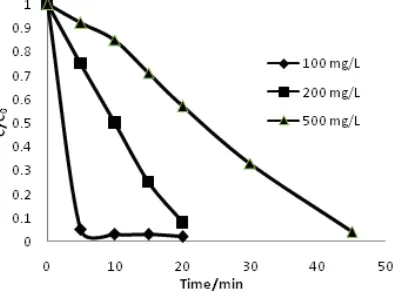ELECTRO-DEGRADATION OF REACTIVE BLUE DYES USING CYLINDER MODIFIED
ELECTRODE: Ti/
β
-PbO
2AS DIMENSIONALLY STABLE ANODE
Aris Mukimin1,*, Karna Wijaya2, and Agus Kuncaka2
1
Center of Industrial Pollution Prevention Technology, Jl. Ki Mangunsarkoro No. 6 Semarang
2
Department of Chemistry, Universitas Gadjah Mada, Jl. Sekip Utara, Pos Box: BLS 21, Yogyakarta 55281
Received April 12, 2010; Accepted October 7, 2010
ABSTRACT
A cylinder modified electrode of the β-PbO2 was fabricated by anodic electro-deposition method on titanium
substrate. The PbO2 layer prepared from high acid solution (pH: 0.3) that contains a mixed of 0.5 M Pb(NO3)2, 1 M
HNO3, and 0,02 M NaF. The physicochemical properties of the PbO2 electrode were analyzed by using Energy
Dispersive X-Ray Analysis and X-Ray Diffraction. The analyses have shown that oxide layer has an O/Pb ratio about 1.6 and the PbO impurities are formed in the surface layer besides the β-PbO2. The modified electrode was used as
anode paired stainless cathode in the electro-degradation of reactive blue dye. The results of the electro-catalytic oxidation process of the dye solution were expressed in terms of the remaining intensity dye and chemical oxygen demand (COD) values. The modified electrode has removal efficiency of the reactive blue dye at voltage of 7 V, pH of 7, concentration NaCl of 2 g/L, initial dye concentration of 100 mg/L with simple and short time operations.
Keywords: Electro-deposition, reactive blue dye, cylinder modified electrode
* Corresponding author. Tel/Fax : +62-24–8316315 Email address : [email protected]
INTRODUCTION
Beside resulting product, many textile industries release pollutants that potentially degrade the quality of the environment. Reactive dyes are the main group of dyes that used in dying process. They contain one or more reactive group that forms covalent bonds with a hydroxyl or amino group on the fiber. They are most serious problem because the low efficient about 50% [1], it is due to the competition between formation of the activated intermediates and hydrolysis reaction [2].
Conventional methods for wastewater treatment of textile industry are usually the biological, physical and chemical techniques. The physical and chemical methods are based on the difference of physical properties and adsorption so the pollutants are only transferred from solution to insoluble phase, while biological method can degrade only pollutants having biodegradability properties. The most disadvantages of these methods are resulted sludge that becomes new wastes [3].
Electro-degradation method is a treatment of pollutant to be transformed into simple compound i.e. H2O and CO2 by electrical field system. Electro-degradation techniques offer many distinctive advantages relative to the other technologies such as environmental compatibility, versatility, energy efficiency, safety, selectivity, amenability to automation, and cost effectiveness [5].The system contain two components i.e. the electronic conductor (electrode) and ionic conductor (electrolyte) [4].
Electrode material is the most important component in the electro-degradation system. Transition metal oxides can be used as the electrode by coating on inert inexpensive material. Many metal oxide surfaces are reacted and can undergo the following surface chemistry on oxidation, an example chlorine evolution: [6]
S-OH → S-O* + H+ + e
S-O* → S-O
S-O + Cl- → 2SOCl + e
SOCl + H+ + Cl- → S-OH + Cl2
Many electrodes have been used such as graphite [7], boron doped diamond [3], SnO2-Sb2O5 [8], RuOx [9-10], IrOx [11] with diverse application. The electrodes are so expensive that they are less applicable for wastewater treatment. PbO2 electrode was cheaper and it had activity similar to that of platinum. In general, the PbO2 electrode prepared by electrodeposition consists of two polymorphs: orthorhombic α-PbO2 and tetragonal β-PbO2. It has been used to treat textile wastewater [12], phenol [13], acid green and sulfur black dyes [14]. The electrode has reasonable removal of pollutants at high voltage, short electrolysis time, and low pH.
The aim of this work is to increase the removal of reactive blue dyes by two ways; (1) synthesize PbO2 by electrodepositing at high acid condition and high voltage on Ti substrate in order to obtain β-PbO2 which has favorable reaction activity. (2) β-PbO2 electrode is designed as cylinder in order to obtain large surface to volume.
Aris Mukimin et al.
EXPERIMENTAL SECTION
Materials
All chemicals and reagents were used as received. NaCl, NaF, NaOH, HNO3 (65%), H2SO4 ((6%), were of analytical grade and purchased from Merck Germany. Reactive blue dye was from Pismatex industry. Titanium sheet (ASTM B.265 Gr.1) was obtained from PT. Steel Surya Mandiri, Jakarta.
Instrumentation
The physicochemical properties were studied by X-ray powder diffraction (Shimadzu 6000) and Energy Dispersive X-Ray Analysis (LEO 420i). The electro-degradation experiments were carried out by DC power supply (GW INSTEK sps-3610). Absorbance measurement were performed using a double-beam spectrophotometer (Hitachi series U-2001)
Procedure
Preparation of modified electrode
Titanium cylinder (Ø 6 cm x 8 cm) was roughened by abrasive papers, using water as lubricant, followed by siliceous paste blasting, and rinsed with cold distilled water. The cylinder was then degreased in 40% NaOH, cleaned in a hot 1:1 mixture of HNO3 and H2SO4 and finally washed with distilled water.
The electrodeposition of PbO2 was performed in solution containing 0.5 M Pb(NO3)2, 1 M HNO3, and 0.02 M NaF. During electrodeposition, the potential range was controlled from 4 to 4.5 V and the process was carried out for 3 h.
Characterization of Ti/PbO2 electrode
The crystalline compositions of the film were determined by Energy Dispersive X-Ray Analysis (EDXA). The crystalline structure of the film was determined by X-ray diffraction (XRD).
Electro-degradation experiment
Electro-degradation experiments were carried out in a cylinder reactor, as shown in Fig 1. The Ti/PbO2 with an active area of 148 cm2 was placed in electrochemical cell as the working electrode, and a stainless steel was used as counter electrode. The distance between the anode and the cathode was kept at 2 cm and the volume of electrolyte in each experiment was 1000 mL. Studies were carried out to achieve high efficiency for the degradation and removal of the reactive blue dye by the electro-catalytic indirect oxidation process. DC power supply (GW INSTEK sps-3610) was used to provide the voltage. Absorbance measurements were performed using
Fig1. Design of Electro-degradation Reactor (1)
Sample flask, (2) Peristaltic pump, (3) Power supply DC, (4) Cathode: Stainless, (5) Anode: Ti/PbO2, (6) pH meter, (7) Magnetic stirrer, (8) Treated sample flask
Fig 2. EDXA Spectrum of the PbO2 film on Ti substrate
a double-beam spectrophotometer (Hitachi series U-2001)
Performance evaluation
The treatment efficiency was evaluated by examining the intensity absorbance and COD value, the later was measured by a closed reflux titrimetric method. The decreasing of absorbance of the reactive blue dye is expected as a result of electro-catalytic oxidation process.
RESULT AND DISCUSSION
Characteristics of the modified electrode
Aris Mukimin et al.
Fig 3. XRD Spectrum of the modified electrode prepared
from 0.5 M Pb(NO3)2, 1 M HNO3, and 0.02 M NaF on Ti substrate for 3 h at a potential of 4-4.5 volt
Fig 4. Spectra of reactive blue dye as a function of pH
after 5 min electro-degradation
Fig 5. Spectra of reactive blue dye as function of NaCl
concentration at 5 min
voltage [15]. The presence of Ti because of the oxidation of titanium substrate which it very slow [16].
The corresponding X-ray spectra are in Fig 3. Attribution of the peaks is performed by using JCPDS, literature [16-18]. A typical XRD pattern of PbO2 prepared on Ti substrate at high acidity and voltage only shows β-PbO2. Two distinct peaks of β-PbO2 at 33.620° with d-value of 2.664 (standard: 2.797) and 50.680° with d-value of 1.799 (standard: 1.8559) were observed. The XRD pattern of the modified electrode has also shown the presence of PbO at 53.350° and 64.180°. The peak is at 37.453° which was formed by Ti (101). Thus, we can conclude that the modified electrode on Ti substrate consists of β-PbO2.
Electro-degradation of reactive blue dye
Operating parameter such as pH, salinity of the electrolyte, initial concentration of dye, applied voltage on dye degradation were studied over the electrolytic ability of the Ti/PbO2 electrode for electro-degradation of reactive dye in water as a model of wastewater.
Effect of pH
The parameter of pH plays an important role in indirect oxidation electro-degradation. Fig 4 shows the effect of initial pH of the solution on dye removal after 5 min electrolysis at 7 volt. Faster dye removal rate was achieved at relatively low acidity close to neutral because the presence of ClO- is higher than Cl2 and HClO at this condition. The equilibrium of the reaction is:
2Cl- → Cl2 + 2e (Anode)
Cl2 + H2O HOCl + H
+ + Cl– R
HClO R H+ + ClO-
At pH 7, the system contains 60% of HClO, 35% of ClO-, and 5% of Cl2 with the relative oxidation power of these species is ClO->HClO>Cl2 [19-20].
The ClO- oxidator is an intermediate spesies that fastly reacts with reactive blue dye as electro-degradation process. Prediction of the reaction mechanism is:
ClO- + R(dye) + 2 H+ R(dye)+2 + H2O+ Cl -→
ClO- + R(dye)+2 + 2 H+→R(dye)+4 + H2O+ Cl
-ClO- + R(dye)+4 + 2 H+→R(dye)+6 + H2O+ Cl
-This reaction is completed if all dye molecules were oxidized to be CO2 and H2O.
Effect of NaCl concentration
The UV-visible spectral changes during the electro-degradation of reactive blue dyes are illustrated in Fig 5. The figure shows a gradual decrease of absorbance at 593 nm. These may be due to both the increase of the conductivity of solution and the present of ClO- as oxidation agent. High conductivities of the solution facilitate the electron transfer so that the electro-degradation has increases [13]. Furthermore, the maximum absorbance band of the solution has shifted from 593 nm to 490 nm after the addition of NaCl concentration due to the formation of the chlorinated reactive blue.
Effect of applied voltage
Aris Mukimin et al.
Fig 6. Spectra of reactive blue dye as function of voltage
at 5 min
Fig 7. % intensity decreasing of reactive blue dye as
function of initial dye concentration at 15 min
Fig 8. The curve of COD and dye removal vs time in
electro-degradation
presents the UV-visible spectra changes after 5 min electrolysis at various voltages under constant pH and NaCl concentration. Two changes can be observed (1) The main absorption band centered at 593 nm significantly decreased at the voltage applied (4–7 V), and the maximum absorption band of the solution shifted to a near wavelength.
Faster electro-degradation of dye was observed at higher applied voltage. It can be explained that, at higher voltage more electrons are transferred to the anode, thus promoting the oxidation of ion chloride (Cl-) to form
hypochlorite (ClO-) which subsequently oxidized the reactive blue dye [8].
Effect of initial concentration of dye
The influence of the initial concentration of the reactive blue dye on the electro-degradation was also investigated. The electro-degradation of reactive blue dye was studied by varying the initial concentration from 100 to 500 mg/L. The quantitative description of initial concentration versus time profiles is presented in Fig 7. It seemed that the degradation of reactive blue dye followed the model of Langmuir–Hinshelwood satisfactorily. The degradation efficiency increased with the decreasing concentration of reactive blue dye. At the dye concentration of 100 mg/L, 95.23% of the dye was degraded in only 5 min. Whereas at the dye concentration of 500 mg/L, the degradation efficiency was nearly 42.61% for electro-degradation time of 20 min.
Mineralization of reactive blue dye
The extent of mineralization of dye was examined by determination of chemical oxygen demand (COD) in the solution. Temporary changes of COD during the electro-degradation of the reactive blue dye are depicted in Fig 8. It shows that dye removal is faster than the mineralization of dye. It can be explained that the electro-degradation of dye removal cleave only chromophore structure, while the mineralization cleave of the whole conjugated chromophore structure of the dye.
The electrode has resulted high efficiency of electro-degradation. The reactive blue dye has been 67% degraded after 5 min electrolysis.
CONCLUSION
Dimensionally stable anode of Ti/β-PbO2 can be prepared by electrodeposition method from high acidity solution (pH: 0.3) and voltage (4−4.5 V). The electrode has high efficiency in removal of reactive blue dye at the applied voltage of 7 V, pH of 7, concentration NaCl of 2 g/L, and initial dye concentration of 100 mg/L with simple and short time operations.
ACKNOWLEDGEMENT
Aris Mukimin et al.
REFERENCES
1. Guaratini, C.C.I., Fogg, A.G., and Zanoni, M.V.B., 2001, Electroanalysis, 13, 18, 1535−1543.
2. Palegrini, R., Zamora, P.P., Andrade, A.R., Reyes, J., and Duran, N., 1999, Appl. Catal., B, 22, 83−90. 3. Yoshida, K., Yoshida, S., Seki, Y., Takahashi, T.,
Ihara, I., and Toyoda, K., 2007, Sei Tech. Rev., 65, 71−73.
4. Bard, A.J., and Fauklner, L.R., 2001,
Electrochemical Method: Fundamentals and Applications, 2nd ed., John Wiley & Sons Inc, 1.
5. Rajeshwar, K., and Banez, J.G., 1997,
Environmental Electrochemistry: Fundamental and
Applications in Pollution Abatement, Academic
Press, New York, 362.
6. Wieckowski, A., 1999, Interfacial Electrochemistry: Theory, Experiment, and Applications, Marcel Dekler Inc, New York, 785
7. Lei, Y., Shen, Z., Chen, X., Jia, J., and Wang, W., 2006, Water SA, 32, 2, 206−211.
8. Ihos, M., Bocea, G., and Iovi, A., 2005, Chem. Bull ”Politehnica” Univ., 51, 65, 1−2.
9. Esteves, F., and Cunha, E.P., 2005, Voltammetric study and elecrochemical degradation of reactive
dyes, 5th World Textile Conference AUTEX,
Portorz, Slovenia, 27-29 June.
10. Inazaki, T.H., Piao, A.C.S., and Bidoia, E.D., 2004,
Braz. Arch. Biol. Technol., 47, 6, 983−994.
11. Lanza, M.R.V., and Bertazzoli, R., 2002, J. Braz. Chem. Soc., 13, 3, 345−351.
12. Chen, X., Shen, Z., Zhu, X., Fan, Y., and Wang, W., 2005, Water SA, 31, 127−132.
13. Zu-Chey, W.V., Ming-hua, Z., Zhi-Wei, H., and Da-Hui, W., 2002, J. Zhejiang Univ. Sci., 3, 2, 194−198.
14. Abu Ghalwa, N.M., and Abdel-Latif, M.S., 2005, J. Iran. Chem. Soc., 2, 3, 238−243.
15. Chen, B., Guo, Z., Huang, H., Yang, X., and Cao, Y., 2009, Acta Metall. Sinica, 22, 5, 373−382. 16. Shen, P.K., and Wei, X.L., 2003, Electrochim. Acta,
48, 1743−1747.
17. Karami, H., and Alipour, M., 2009, Int. J.
Electrochem. Sci., 4, 1511−1527.
18. Olivera-sausa, A., and Liona-neto, P., 2002, J. Braz. Chem. Soc., 13, 2, 218−225.
19. Yasus, N., Shigeo, K., and Hiromba, W., 2003,
Hitachi Hyoron, 85, 2, 213−216.
20. On-site production of chlorines,


